The defeat of the Italian army in the Battle of Caporetto. H. 2
Breakthrough front
On the night of October 24. 1917, the artillery of the Austro-German forces began shelling the positions of the Italian army. Chemical shells were also used. Basically, shelling of second-line positions, command posts, artillery batteries and communication lines were conducted. In a very short period of time, terrible force fire fell upon the positions of the Italian troops. Fortifications were destroyed, trenches, dugouts and shelters were destroyed by hurricane fire, the connection between command posts and forward positions was interrupted. The chemical attack also bore fruit, as the Italian chemical defenses were imperfect. The artillery attack was extremely successful: the Italian defense was largely disorganized.
The main blow fell on three divisions of the 4 corps and one division of the 27 corps (19). Strong fire upset the defense of the first line. And the Italian artillery was unable to respond effectively: the enemy’s fire destroyed the communication, command errors also had an effect that, just before the attack, began to withdraw troops and artillery, confusion began, which intensified with the onset of the enemy offensive. The Italian retaliatory fire was so weak that the Austro-German command even decided that the enemy in the first line had only a weak artillery cover and had already managed to pull most of the troops and artillery back. Italian artillery was almost silent.
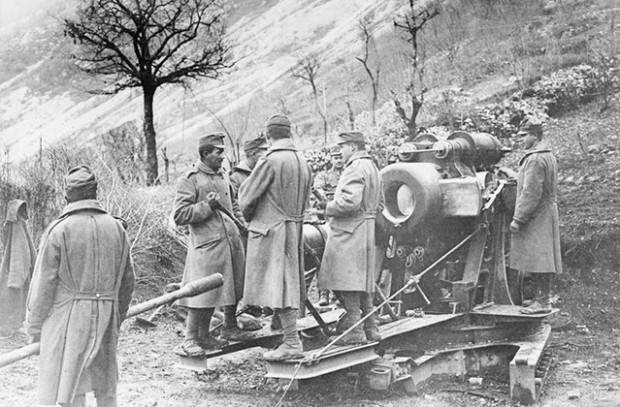
Austrian artillery calculation in 305-mm howitzers. Battle of Caporetto. October 1917
At 8 in the morning, the infantry of the 14 of the Austro-German army launched an offensive on the front of the 4 and 27 of the Italian corps. The Krauss group, which is advancing on the right wing of the shock group of the army, was to take the Saga and Mount Stol to force the enemy to retreat along the whole front in front of the threat of flank girth. To 9 watches 30 min. the front of the Italian corps was broken and the Austrians advanced along the bottom of the valley, but were kept by the Saga. The Italians resisted for a while in the neighboring Rombon sector, but then retreated, fearing a flank attack from the enemy moving in the valley. By 14 hours, the Austrians also broke through the front of the 43 division. Part of the 43 Division during the day still fought back at Monte Nero, when the troops were surrounded and lost communication. Alpine shooters resisted for several more days.
A group of Stein attacked the junction of two Italian corps north of Tolmino. The 46-I Italian division was attacked by the 50-nd Austrian and 12-German divisions. Part of the troops of the 46 division had fiercely resisted and fought even when they were bypassed and they found themselves in a hopeless situation. However, in other places the Italians were quickly crushed and this led to a breakthrough of the defense between Mrzli and the river. In the Tolmino area, only the weak parts of the Neapolitan Brigade of the 19 Division held defenses. German troops easily broke the resistance of the Neapolitan Corps battalion at the junction of the two corps and made their way to the right bank of the Isonzo. This led to the fall of the defense on the left bank of the Isonzo. Around 11 watches the enemy captured the second line of defense. Around 16 watches, the enemy took Caporetto, a village, whose name the entire battle would be called.
Meanwhile, the Alpine Corps of the Berrera group attacked the Italian position at Tolmino. Skillful attack Alpine arrows broke the first line of defense. 12-I German division got the opportunity to move forward on both sides of the river. Thus, in the evening of the first day of the offensive, the Austro-German troops captured three lines of defense on the front of the 27 corps, took Caporetto, and destroyed the entire system of advanced defense of the 4 corps. On this and the following days, most of this corps was captured.
On the Bainzitz plateau, the troops of the 24 and 27 buildings were attacked by superior enemy forces, but withstood the blow and counterattacked themselves. They even captured several enemy positions. The commander of the 24 Corps, General Cavillo, was ready to continue the struggle and took command of parts of the 27 Corps located in the area. However, the maneuver group Scotti created a threat to the Italian troops on the plateau from the rear. The commander-in-chief of the Italian army, Luigi Cadorna, ordered the troops to retreat to the main line of defense and, if necessary, to cross back through the Isonzo. An attempt to organize a withdrawal from the plateau failed, as the enemy’s forces at that moment attacked, taking many prisoners and pushing the remaining Italian units to the south.
On October 25, the commander of the 2 Army reported to Cadorna that the breakthrough of the front of the 4 Corps had led to the fall of the entire defense line east of Isonzo, that the enemy was attacking Kreda, successfully attacking Stol and pressing on Luiko. Alpine Arrows defended so stubbornly that they were able to move away from Pletstso and Monte Nero, but the enemy took this position as well. Austro-German troops also took the mountain Matajur. October 26 The 2-I army could not hold on the rear line of defense and the breakthrough reached the width of 28-30 km and 10-15 km in depth. Cadorna ordered the troops to retreat to the Tagliamento River. The 4-I Italian army also had to withdraw from the Cadorian Alps to a new line of defense. For the first time since the beginning of the war in the Isonzo area, the enemy entered Italian territory.
On the morning of October 27, the 3rd Army of the Duke of Aost received an order to withdraw. The positions that Italians seized at the cost of such enormous losses had to be abandoned. The 3rd Army was not defeated, but there was a threat of an enemy breakthrough to the rear, and it could be surrounded. Before the retreat, the lowlands were flooded to slow the movement of the enemy. The evacuation of troops from the coastal region on the right flank of the 3rd Italian army was carried out with the help of fleet. The naval command received an order about this on October 26 and carried it out, despite adverse factors - unrest at sea, high water at Isonzo, attempts to counter the enemy fleet and aviation. At the same time, several thousand sailors strengthened the coastal defense, trying to prevent the enemy’s bypass movement along the seashore. After the successful evacuation of people and a large amount of military equipment, the fleet set about solving the task of strengthening the defense of Venice.
Huge masses of people, guns and carts rushed to the rear. Part of the troops went in good order, maintaining morale, discipline and weapon. Especially distinguished troops 3-th army, which did not suffer defeat. However, in many Italian parts panic reigned, they turned into crowds of dissolved rabble. The big disorder in the columns of the retreating troops was made by refugees, whose number reached 400 thousand people. As far as possible, troops destroyed bases and depots, blew up bridges, but Austro-German troops seized a huge amount of weapons, supplies and military materials.
October 29 The 3 Army managed to retreat beyond the Isonzo without any problems. Her left flank was covered by the right wing of the 2 Army (6 and 8 Corps), which was subordinated to the Duke of Aosta. However, the 7 body was still crushed by the enemy. On the same day, the Austro-German army captured Udine, from where the high command and the headquarters of the 2 army barely managed to leave. General Cadorna tried to counteract the advance of the enemy, throwing one brigade after another into an ever-expanding breakthrough. However, without much success. The High Command formed a new special corps, General Di Giorgio, who was supposed to restrain the offensive of the enemy.
Thus, the troops of the 2 and 3 armies and the Carnius group retreated. The 4 Army began its retreat from the Cadorian Alps. Initially, he planned to organize a new line of defense on the Tagliamento River, but this was not possible. Then they decided to stop the enemy on Piave.
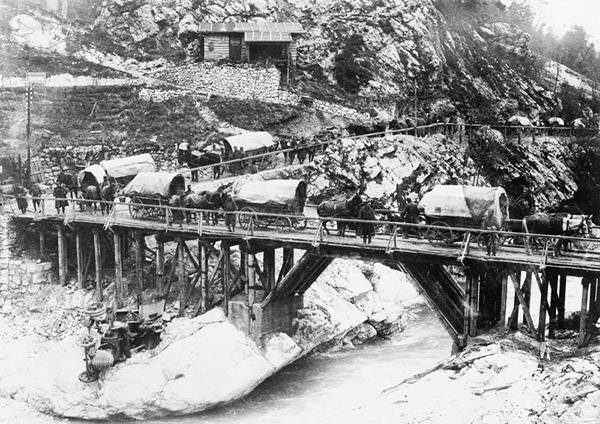
Italian troops retreat
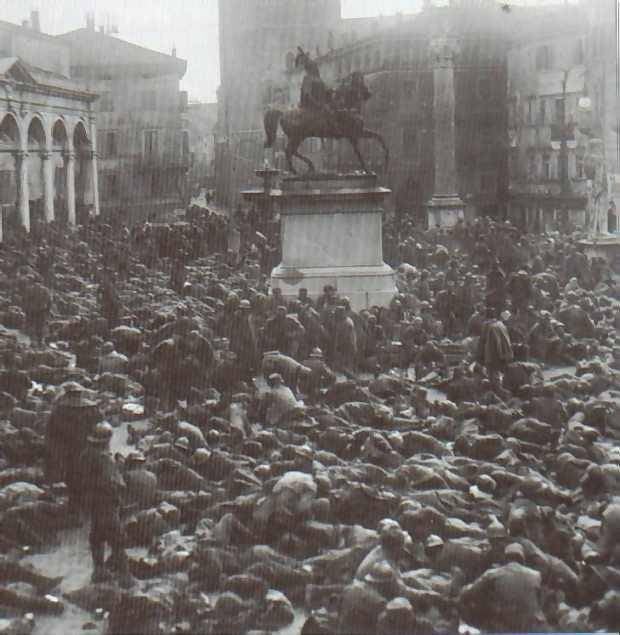
Retreating 2 Italian Army in Udine
The continuation of the battle
England and France, seeing the catastrophic situation in Italy, declared their readiness to support the allies. On the morning of October 30, General Foch arrived in Treviso, where the supreme Italian command was relocated. Soon British and French divisions began to arrive in Italy (before the end of the year 11 arrived). Military historian General Andrei Zayonchkovsky wrote: “Some of the vehicles were transported [by the French] by rail to Nice, for two weeks they worked on bringing infantry and supplies. Part of the convoy independently passed [from France] through the Alps, making the transition through mountain passes with a height of 1500 meters on roads covered with snow, with sharp turns and frequent ascents. ”
Cadorna wanted to send the Allied forces to the wooded upland of Montello, which dominated the middle course of the Piave River. Also, the area linked the 4 Army, retreating from the Cadore Alps, with the 3 Army on the lower course of Piave, while the remnants of the 2 Army would be put in order. But Foch opposed. He was afraid that the Italian troops developed at Caporetto would bring chaos to the allied units. In addition, the new line of defense was not ready. Foch believed that the Italians themselves should stop the enemy on the lines of Tagliamento and Piave, and in the region of Trentino. Foch decided to keep the French troops between Brescia and Verona for the time being. The French and British troops in Italy submitted only to their commanders.
However, despite the failure of the Allies to immediately enter the front line, the appearance of Allied divisions had a general positive effect on the situation at the front. Cadorna was able to transfer some Italian units from calm sections of the northwestern front to the east. Italians, having learned about the arrival of the Allies, somewhat cheered up. The Italian command took emergency measures to restore the front. The remaining cavalry (half already hurried and used as infantry), inactive for almost the entire war, was thrown into battle and was able to detain the enemy on the plain, attacking his vanguards. Italian cavalry showed samples of courage and resilience. Thus, the Genoese and Novarsky Ulan regiments, supported by the Bersaliers, fought to the death and almost completely died, restraining the onslaught of the enemy and winning time for other troops. Italian aviation also played a major role in deterring the movement of the enemy. Italian planes shot down enemy vehicles and bombed the advancing Austro-German troops.
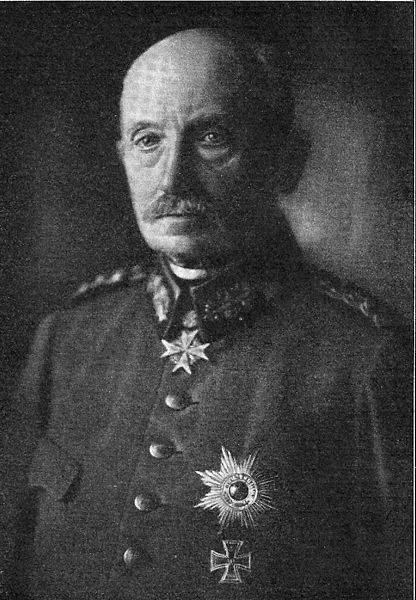
Otto von Belov, Commander of the 14 Austrian-German Army
October 30 - November Italians 1 rose to blow up the bridges over the Tagliamento, although not all the troops completed the crossing. As a result, a significant amount of infantry and artillery was captured by the enemy. Including a lot of heavy and medium guns, which managed to withdraw from the plateau Beinsitz. The Italian command deployed considerable forces on the right bank of the Tagliamento. However, 2 - On November 3, the Austro-German forces launched a crossing in the upper course of the river and created a flank threat to the Italian group downstream the Tagliamento. On November 3, the Commander-in-Chief of the Italian army, General Cadorna described the situation on the front to the chairman of the Council of Ministers: “The 2-I army lost 180 thousands of prisoners, 400 thousands of people scattered, the mass of people lost moral stability. ... If I succeed in withdrawing the 3 and 4 armies in order, I intend to play my last card on the Piave and wait for a decisive battle there. ”
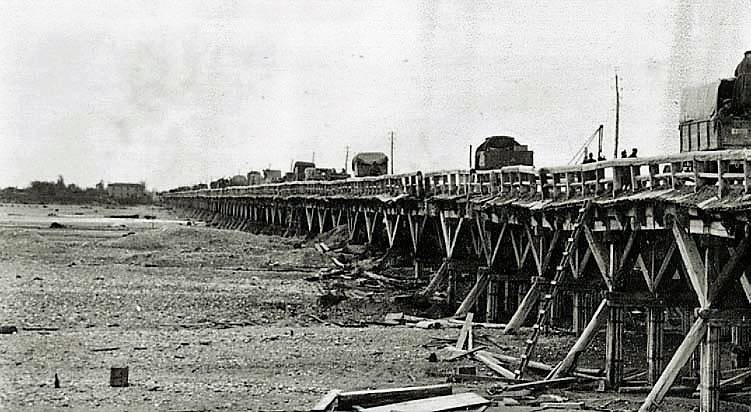
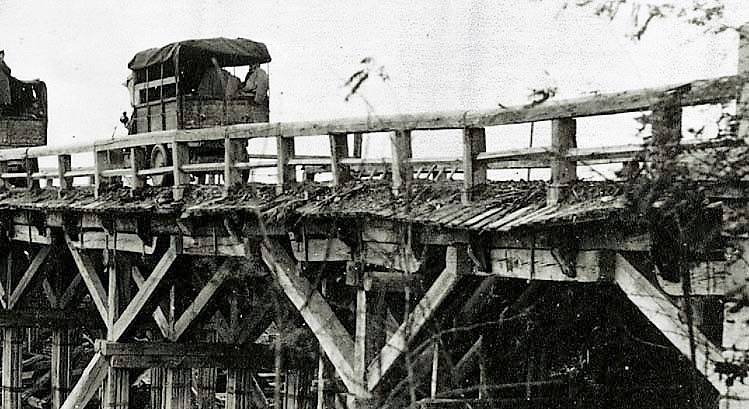
Italians continued to withdraw. The special corps of General Di Giorgio led persistent rearguard battles, restraining the onslaught of the enemy, so that the troops of the 3 Army calmly reached Piave and crossed over it. The 36-I and 63-I divisions, departing from the foothills of the Carnic Alps, were cut off from the withdrawal paths. They had to break through to the south with a fight. 5 - 6 November, they broke through to their own, but in the end their remnants were surrounded and forced to surrender.
Meanwhile, the Austro-German offensive began to slow down. General Boroevich with the Austro-Hungarian armies (Isonts group) failed to tie down the 3 Italian army, it retained its combat capability and retreated in perfect order. The Austrians did not show enough energy during the pursuit, the previous battles greatly weakened their combat capability. Trying to advance in the northwestern direction, the Austrians crossed the line of attack of the 14 Austrian-German army, causing confusion in its movement, which caused irritation of von Bülow. The Germans believed that the failure of further movement was caused by the inability of the allies. Persistent rearguard battles and the self-sacrifice of the Italian cavalry also played their part. In addition, the Austro-German troops were not ready for such a failure of the enemy and were unable to quickly develop the offensive. The Austrian army did not have enough moving units capable of quickly pursuing the enemy and occupying important objects and positions. Not prepared and materials for the restoration of the Italians destroyed roads and bridges, which restrained the movement of the Austro-German troops. The command could not establish normal interaction between the attacking units.
The Austro-German command did not have a strategic reserve to develop the first great success. So the scale of the unexpected success in Italy amazed even the Germans themselves, including Erich Ludendorff, who in those days regretted that he could not find a few more divisions for the Italian front - then the Germans and Austrians would have real chances to bring Italy out of the war altogether.
Thus, the Austro-German army achieved impressive success, but the command lost control as the troops moved forward and was unable to fully use the first success. That is, in many ways the Italians were lucky.
Battle of Caporetto
To be continued ...
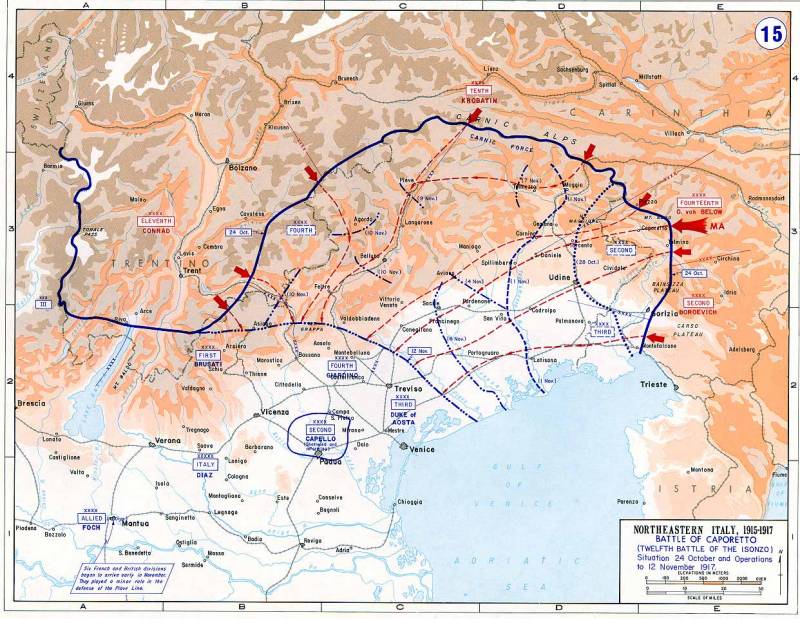
Information